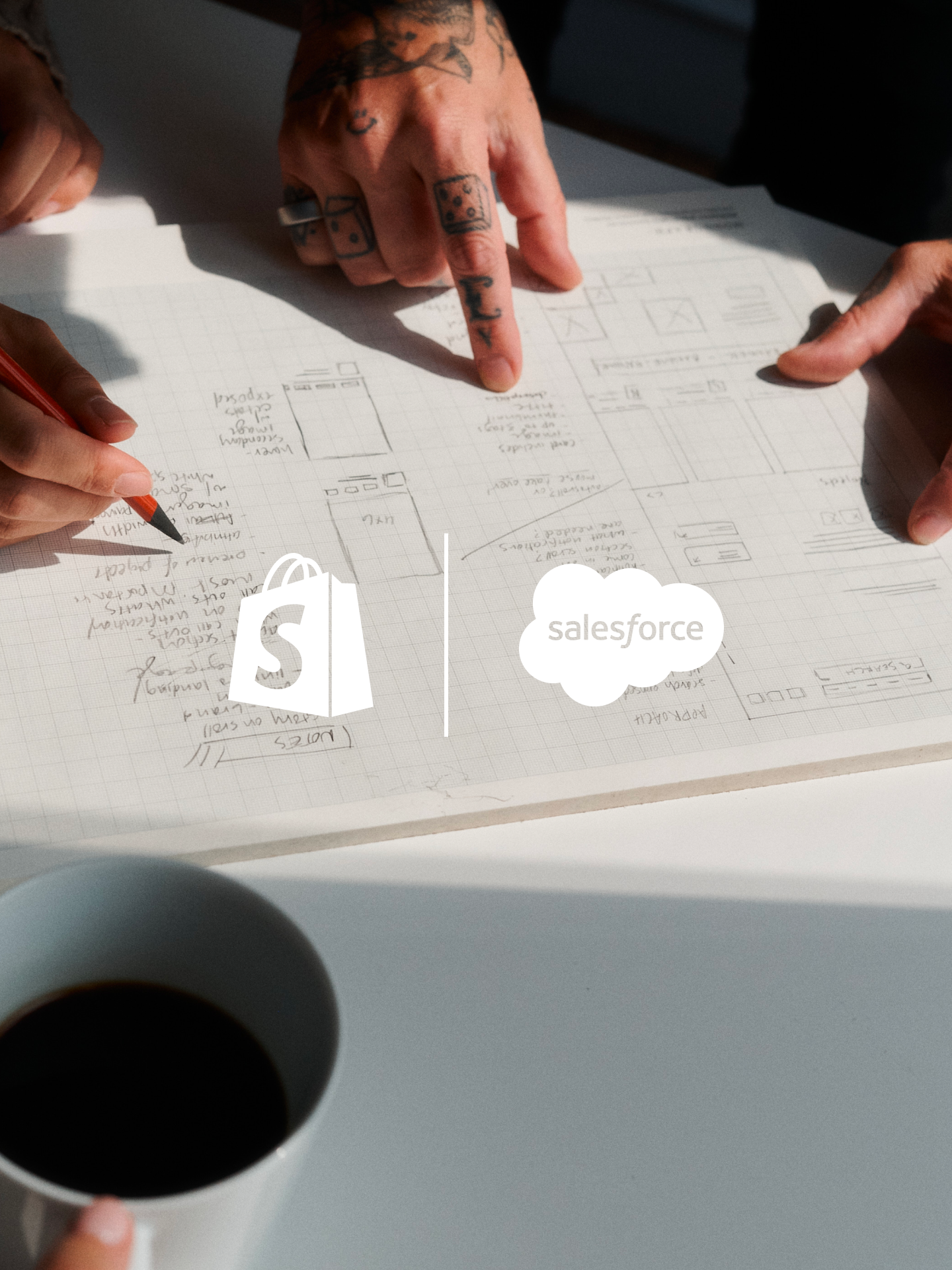As engineering and digital leaders look to reduce operational friction and accelerate innovation, Shopify is emerging as the strategic choice, offering modern infrastructure, faster development cycles, and a dramatically lower total cost of ownership.
We dive deep into these trends in our new whitepaper: SFCC to Shopify: The Enterprise Migration Guide.
What’s Driving the Migration from SFCC?
Over the past 18 months, we’ve seen a clear pattern: CTOs, VPs of Engineering, and ecommerce architects are increasingly questioning whether Salesforce Commerce Cloud is the right platform for the next stage of growth.
Here’s what they’re telling us:
1. Mounting Operational Overhead
Custom infrastructure, deployment pipelines, and SI-dependent workflows have created unnecessary layers of complexity, slowing teams down.
2. Slow Time to Market
New features, checkout changes, and marketing campaigns take too long to launch due to SFCC’s proprietary architecture and testing requirements.
3. Limited Developer Experience
Proprietary tooling, like ISML and Business Manager, slows down onboarding and limits hiring flexibility. Developers are frustrated by the lack of modern tools and real-time testing.
4. Unpredictable Costs
Between licensing fees tied to GMV, partner retainers, and internal DevOps, the total cost of running SFCC can become unpredictable and unjustifiable.
TL;DR: What was once considered a powerful enterprise solution is now a source of technical debt and velocity loss.
From Bottlenecks to Breakthroughs: Why Shopify Is the Platform to Scale With
Shopify has matured into an enterprise-grade platform built for the speed, scale, and agility modern brands demand. The advantages are especially clear to technical decision-makers.
Here’s how Shopify compares to Salesforce Commerce Cloud across five critical dimensions (explored in detail in our whitepaper):
Infrastructure & Operational Overhead
Shopify eliminates DevOps burden with fully managed infrastructure, global CDN, built-in compliance, and 24/7 availability. No more custom hosting environments or SI-led deployments.
Speed of Development
In-house teams move faster on Shopify. Real-time previews, Git-based workflows, and CI/CD compatibility enable quick iteration and release cycles.
Scalability & Performance
Shopify’s infrastructure auto-scales, handling peak traffic, international storefronts, and B2B order volume without the need for manual tuning or vendor optimization.
Developer Experience
Shopify supports modern technologies—Liquid, React, GraphQL—and allows devs to ship faster without learning platform-specific languages like ISML.
Total Cost of Ownership
With fewer middlemen and predictable pricing, Shopify offers lower TCO. Brands can reinvest time and capital into innovation, not platform maintenance.
New Whitepaper: A Technical Guide to Migrating from Salesforce to Shopify
Our latest whitepaper, Replatforming for Enterprise Brands: Salesforce to Shopify, is designed specifically for technical leaders who are evaluating this transition. Inside, we cover:
- Core architectural differences between Salesforce and Shopify
- Migration methodology based on 200+ platform transitions
- Common misconceptions about Shopify’s enterprise capabilities
- B2B and multi-market support on Shopify
How to plan and execute a phased migration; from discovery to post-launch optimization
What Does a Typical SFCC to Shopify Migration Timeline Look Like?
Based on our work with complex enterprise migrations, here’s what to expect:
| Complexity Tier | Typical Profile | Estimated Migration Timeline* |
|---|---|---|
| Tier 1 – Standard | <10k SKUs, basic integrations | 20–24 weeks |
| Tier 2 – Advanced | 10k–50k SKUs, moderate B2B | 26–36 weeks |
| Tier 3 – Enterprise | 50k+ SKUs, multi-region, custom logic | ~42 weeks |
*Dependent on catalog size, data models, and business readiness.
Our whitepaper includes a detailed migration framework designed to help you assess risk, align stakeholders, and plan your move with confidence.
Debunking Common Myths About Shopify for Enterprise
Despite powering some of the world’s largest brands, there are still myths around Shopify’s suitability for complex enterprise needs. Here’s the reality:
- “Shopify can’t support B2B.”Shopify now includes native B2B features, custom pricing, tiered access, and multi-account management.
- “Shopify isn’t flexible enough.”Shopify Functions and its API-first approach make it highly extensible, even for advanced workflows.
- “It’s just for DTC brands.” Shopify Plus powers multi-brand, multi-region, and wholesale giants, handling global scale effortlessly.
Plan with Confidence. Migrate with Speed.
Migrating platforms isn’t just a tech upgrade, it’s a strategic decision that impacts every part of your business. Our guide walks you through:
- Evaluating risk
- Creating a phased migration roadmap
- Aligning internal teams
- Defining post-migration success metrics
- Knowing when and how to engage expert support
Need a Migration Partner? We’ve Done This Before.
As a Platinum Shopify Engineering Partner, Domaine has led replatforming efforts for global brands moving off SFCC. From 10k SKU catalogs to complex B2B rollouts and ERP integrations, we specialize in high-stakes migrations, done right.
If SFCC is slowing your team down, it's time to reassess. A move to Shopify isn’t just about modernization, it’s a leap forward in speed, control, and scalability.
FAQs
Why are enterprise brands migrating from Salesforce Commerce Cloud (SFCC) to Shopify? Many enterprise brands find SFCC is creating operational overhead, slowing down new feature launches, offering a limited developer experience, and leading to unpredictable, high costs. Shopify provides modern infrastructure, faster development, and a lower total cost of ownership.
What specific challenges do brands face with SFCC? Brands often experience mounting operational overhead due to custom infrastructure, slow time to market for new features, a limited developer experience with proprietary tools, and unpredictable, often high, costs from licensing and retainers.
How does Shopify address these challenges for enterprise brands? Shopify eliminates operational overhead with fully managed infrastructure, enables faster development through modern workflows, provides a better developer experience by supporting modern technologies, and offers a more predictable and lower total cost of ownership.
Is Shopify truly capable of handling enterprise-level complexity like B2B and multi-region operations? Yes, Shopify is built for enterprise needs, offering native B2B features, support for multi-brand and multi-region operations, and extensibility for advanced workflows through its API-first approach and Shopify Functions.
What does a typical SFCC to Shopify migration timeline look like? Migration timelines vary by complexity: standard migrations might take 20–24 weeks, advanced ones 26–36 weeks, and enterprise-level projects around 42 weeks, depending on factors like catalog size and business readiness.
What resources are available for brands considering this migration? Our whitepaper, SFCC to Shopify: The Enterprise Migration Guide, offers a comprehensive technical guide covering architectural differences, migration methodologies, and planning for a phased transition.
Can Domaine help with my brand's migration? Yes, as a Platinum Shopify Engineering Partner, Domaine specializes in high-stakes migrations for global brands moving off SFCC, with extensive experience in complex catalogs, B2B rollouts, and ERP integrations.














